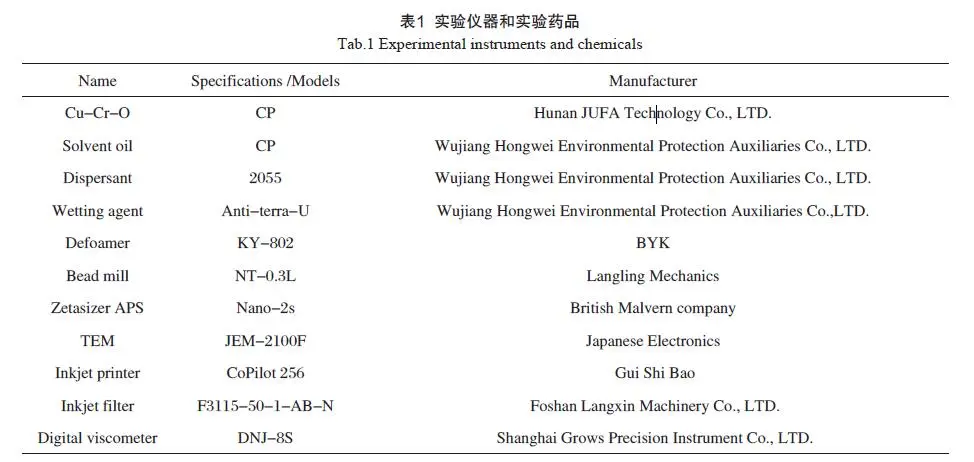Ceramic inkjet printing technology has emerged as a perfect blend of modern computer technology and ceramic surface decoration techniques, showcasing unparalleled advantages over traditional decorative methods. The core of this technology lies in the preparation of ceramic ink, and this study focuses on the development of black ceramic ink using a grinding-dispersion method. Furthermore, we delve into the performance of this ink under different solid content conditions. Subsequently, we subject the ink to high-temperature resistance testing to explore its behavior in elevated temperature environments, ranging from 600°C to 1000°C.

The experimental results indicate that we have successfully created a high-temperature-resistant black ceramic ink. Even after being subjected to 800°C for 30 minutes, the ink retains its vibrant color, sharp patterns, and exhibits no signs of fading. However, beyond 800°C, the ink's color begins to dull.
Currently, inkjet printing technology, both domestically and internationally, is rapidly flourishing, with its applications extending to various fields. Ceramic inkjet printing technology, as a non-contact printing method, allows for the direct application of ceramic ink onto ceramic products through computer control, serving the purpose of decoration and beautification. Its advantages, including speed, personalization, and fine printing, surpass those of traditional techniques that are limited by size and shape. Additionally, ceramic inkjet printing technology has minimal environmental impact, making it highly suitable for applications such as ceramic surface decoration.
Ceramic ink, as the key component of ceramic inkjet printing, typically consists of ceramic pigments, solvents, dispersants, binders, surfactants, and other additives. Various methods are employed for preparing ceramic ink, including sol-gel, reverse microemulsion, and dispersion methods. The dispersion method, in particular, is commonly used. It involves the use of zirconia beads as grinding tools in a sand mill. By adding appropriate dispersants and other additives, the milled ceramic pigments are uniformly dispersed in the ink medium, forming a stable dispersion system.
Apart from decoration, ceramic ink finds applications in identifying and tracing items on ceramic surfaces, such as printing logos, barcodes, and QR codes. This is especially relevant for honeycomb ceramics, an industrial catalytic material that often requires the printing of barcodes, QR codes, and production information on its surface for identification. However, the heat treatment of cordierite honeycomb ceramics demands temperatures as high as 600°C, necessitating black ceramic ink that can withstand temperatures above 600°C without undergoing chemical reactions with the ceramic substrate and maintaining stable color. Thus, this study chose copper-chromium black ceramic ink and employed the grinding-dispersion method for its preparation. We conducted experiments to investigate the impact of different solid content levels on ink performance and its high-temperature resistance.
In the experiments, we discovered that solid content directly affects the stability and coloration of ceramic ink. Higher solid content enhances ink stability but reduces its coloration ability. Therefore, by appropriately increasing the solid content while maintaining other properties unaffected, we can reduce ink consumption during practical use while improving coloration and coverage. However, excessively high solid content may compromise ink stability, leading to a shortened lifespan of the printing equipment. Therefore, the selection of the optimal solid content is crucial in the preparation of ceramic ink. Under constant grinding parameters, we chose ceramic inks with solid contents of 20%, 25%, and 30% and tested their viscosity and particle size performance to determine the ideal solid content ratio.
The experimental results showed that within the 20%-30% solid content range, an increase in solid content led to a rise in the viscosity of ceramic ink. This increase in viscosity is attributed to higher viscosity enhancing frictional resistance between particles and the dispersion medium, aiding in particle refinement and improved grinding efficiency. However, when the solid content exceeded 35%, the ink's viscosity sharply increased, negatively impacting grinding efficiency and causing particle aggregation. Therefore, choosing the right solid content is a delicate balance between stability and coloration. With the same grinding time, ceramic inks with different solid contents exhibited minimal variation in particle size distribution. Consequently, we opted for a 30% solid content for subsequent studies.
Furthermore, the study revealed that at a 30% solid content, appropriately extending the grinding time resulted in a smaller average particle size. With prolonged grinding time, the average particle size gradually decreased. Nevertheless, after 1.5 hours of grinding, the particle size showed no significant changes. This phenomenon occurs because, after being refined in the grinding mill to a certain size, further extending the grinding time does not substantially alter the particle size. Therefore, we chose a grinding time of 1.5 hours for ceramic ink preparation.
For ceramic ink with a 30% solid content, we conducted inkjet printing tests. The results demonstrated excellent printing performance, with clear patterns, vibrant colors, and no defects such as air bubbles or trailing. This finding indicates that ceramic ink with a 30% solid content is suitable for industrial production and applications.
Finally, we subjected the ceramic ink to high-temperature resistance testing, with firing temperatures ranging from 600°C to 1000°C. The results showed that within the 600°C to 800°C range, the ink's pattern remained largely unchanged, retaining its bright color without yellowing, cracking, or other issues. However, at 900°C, the color of the pattern slightly diminished, and at 1000°C, the color became noticeably darker. This change might be attributed to oxidation-reduction reactions occurring between the ceramic ink and the cordierite honeycomb ceramic substrate. Consequently, we set the application temperature for the high-temperature-resistant ceramic ink at 800°C.
In summary, this study successfully prepared high-temperature-resistant black ceramic ink, optimized its solid content, grinding time, particle size, and other parameters. This ink is suitable for various ceramic inkjet printing applications, particularly those requiring high-temperature resistance. The research provides robust support for the application of ceramic inkjet printing technology, promising significant contributions to ceramic decoration and industrial fields.

Submit your demand,
we will contact you ASAP.

Sanxin New Materials Co., Ltd. focus on producing and selling ceramic beads and parts such as grinding media, blasting beads, bearing ball, structure part, ceramic wear-resistant liners, Nanoparticles Nano Powder

